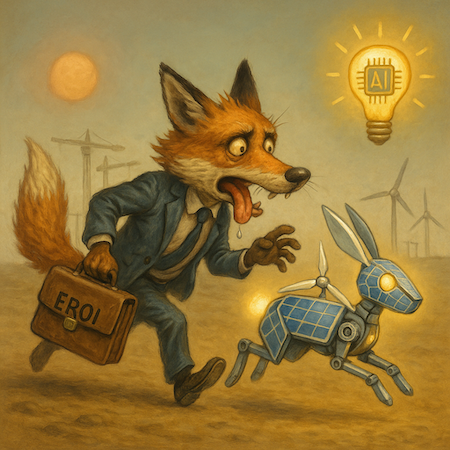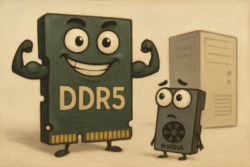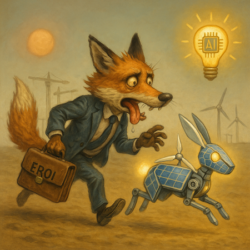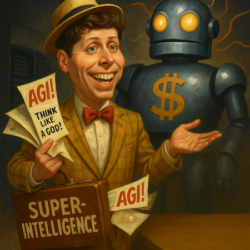- Why the energy transition is unravelling now
- The turning circle of an energy system is very large
- Can renewables create the future?
For a fox to survive, it doesn’t just have to catch the hare. It has to expend less energy catching the hare than it recovers eating it.
The longer the chase, the worse the odds.
This concept is called EROI – energy return on energy invested. It’s the equation of life. All our daily activities boil down to it.
Everything we consume and do is an expression of energy. And the inputs must outweigh the outputs.
How much food we grow is determined by the amount of energy applied to growing it.
Our supply of resources is determined by the energy applied to mining and refining.
Improving those resources is an expression of energy too. Steel is an expression of energy applied to iron. But the usage of steel has to be so much better than iron that it more than offsets the energy spent.
Even energy itself is subject to the same concept. An oil field that uses so much steel and diesel that it expends more energy than it produces would be unproductive.
Our prosperity grows based on how efficiently we turn energy into more energy – EROI. A skilled fox knows when to make his move and when not to bother. Different ways of making steel use different quantities of energy. Some of them don’t make sense.
Back in 2023, I made the case that the shift to renewables meant a lower EROI. We’d have to put more energy into our energy system to get out less.
In some cases, renewables may even have a negative EROI. It’s an oversimplification, but here’s how to think about it: it takes more energy to produce a wind turbine than that wind turbine will produce over the course of its lifetime. The fox spends more energy chasing the hare than he recovers.
But in general, I warned that the EROI on renewables will be so low that our overall prosperity will take a hit. We’ll spend so much more of our economy and workforce building renewables that it will encroach on all the other things we actually want.
An expensive obsession
While fossil fuels still dominated our grid, we could afford to produce low EROI projects like wind farms. We had the high EROI of coal and gas to make it possible.
But as the share of renewables on our grids grew, their EROI began to matter ever more. The EROI of renewables began to have an impact on the availability of energy.
Now that our grids rely on renewables and their vast infrastructure and storage systems, the EROI equation has shifted. The EROI of renewables defines how much energy we have to produce things.
This concept is now playing out in real time.
Bloomberg:
Vestas Wind Systems A/S halted development of a major factory in Poland to produce blades for offshore wind turbines as higher costs from materials and interest rates dim the growth outlook for the technology in Europe.
The Australian Financial Review:
“Victoria’s green energy build almost doubles in price.”
The Guardian:
“One of world’s biggest windfarm developers to cut quarter of workforce.”
Bloomberg:
“In the past two quarters, not a single firm order was made for offshore-wind turbines anywhere else in the world [other than China], according to data compiled by BloombergNEF. Projects keep getting canceled or delayed due to supply-chain bottlenecks or policy reversals”
What went wrong?
Renewables have undermined what’s still possible at a positive EROI.
The cost of manufacturing surged because of higher energy prices. Those higher energy prices show up in higher steel prices, for example.
And because renewables are so low EROI, they are amongst the first things to become uneconomical.
Only the country that is using fossil fuels to manufacture renewable energy goods continues to do so at scale – China.
The pivot back to “reliable” energy is already accelerating. Countries like Spain and Germany are pivoting back to coal and gas to protect their grid stability.
Here’s what worries me…
The turning circle of energy systems is dangerously large
Sustaining our renewables-based electricity grid has become frighteningly expensive. The amount of infrastructure projects, energy rationing and electricity prices are now an undeniable burden.
But we are stuck with it for years to come. We must transition to whatever is next using what we have now.
It’s hard to build nuclear power plants when you’ve made industry unprofitable due to high energy prices. When you’ve offshored engineering expertise. And when upgrading the grid is taking so much of your money.
It’s not just wind farms that are more expensive, after all. It’s everything.
This is the first time in human history that we have transitioned to an energy system with a lower EROI. So, we don’t really know what happens next.
I’m growing very worried that we’re about to go into hibernation, like a bear facing winter. The positive EROI opportunities will simply not be there in a system powered by renewables. The cost of energy is so high that only the lowest hanging fruit will get picked.
Better to sleep through and wait for the salmon to jump into your mouth next spring.
Innovations that upend EROI
There are only two ways to grow an economy: Use more energy… or use what you have more efficiently.
That’s what every breakthrough in history has done from the steam engine to the microchip. Each one took the same amount of energy and squeezed more value from it.
Now, Artificial Intelligence is about to do the same.
It’s the single greatest leap in efficiency the modern world has ever seen — a technology that can multiply output without multiplying cost.
But the question is: which company will harness AI’s power most effectively?
Which business will achieve radically more per unit of energy, time, and capital than anyone else?
On Thursday, October 30th at exactly 9 p.m. ET, I believe we’ll get that answer.
And when we do, it could trigger a huge move for one stock — the kind of move that rewards those who saw it coming before the announcement.
Click here to learn everything before the deadline.
Until next time,

Nick Hubble
Editor at Large
P.S. The fox that survives isn’t the fastest, it’s the one that knows exactly when to run. A possible move from Apple could spark one of the biggest tech shakeups we’ve seen. Don’t wait for the headlines — this is your moment to move first. Click here to learn everything.




